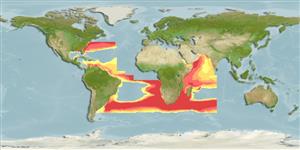Elasmobranchii (sharks and rays) >
Squaliformes (Sleeper and dogfish sharks) >
Etmopteridae (Lantern sharks)
Etymology: Etmopterus: Greek, ethmos, -ou = sieve or ethmoides bone + Greek, pteron = wing, fin (Ref. 45335).
Environment: milieu / climate zone / depth range / distribution range
Ecology
Marine; pelagic-oceanic; depth range 25 - 1200 m (Ref. 106604). Deep-water; 40°N - 45°S
Western Atlantic: Virginia and Florida (USA), Uruguay and Argentina; reported off Suriname (Ref. 13608) and Brazil (Ref. 57911). Southeast Atlantic: off the eastern Cape and northern Natal in South Africa (Ref. 11228). Some reports of this species from the southeast Atlantic may be misidentifications of the recently described Etmopterus compagnoi (Ref. 36731).
Length at first maturity / Size / Weight / Age
Maturity: Lm ?, range 33 - ? cm
Max length : 35.0 cm TL male/unsexed; (Ref. 36137); 33.0 cm TL (female)
Dorsal spines (total): 2; Anal spines: 0. A stout lanternshark with a short tail and small conical denticles, not forming conspicuous lines along the body (Ref. 5578). Brown above, becoming black ventrally with inconspicuous, elongated, broad black marks along the caudal fin and at its base (Ref. 5578).
Found on outer continental shelves and upper slopes on or near the bottom at depths of 100 to 1,000 m; also pelagic at depths of 70 to 480 m over water 2,240 m deep off Argentina (Ref. 247). Feeds on bony fish, octopus, squid and deep-water shrimp (Ref. 5578). Ovoviviparous (Ref. 205).
Life cycle and mating behavior
Maturity | Reproduction | Spawning | Eggs | Fecundity | Larvae
Distinct pairing with embrace (Ref. 205). Pups born with 13 cm length.
Compagno, L.J.V., 1984. FAO Species Catalogue. Vol. 4. Sharks of the world. An annotated and illustrated catalogue of shark species known to date. Part 1 - Hexanchiformes to Lamniformes. FAO Fish. Synop. 125(4/1):1-249. Rome, FAO. (Ref. 247)
IUCN Red List Status (Ref. 130435: Version 2024-2)
Threat to humans
Harmless
Human uses
Fisheries: of no interest
Tools
Special reports
Download XML
Internet sources
Estimates based on models
Preferred temperature (Ref.
123201): 7.7 - 16.5, mean 12.7 °C (based on 176 cells).
Phylogenetic diversity index (Ref.
82804): PD
50 = 0.5000 [Uniqueness, from 0.5 = low to 2.0 = high].
Bayesian length-weight: a=0.00380 (0.00194 - 0.00745), b=3.09 (2.92 - 3.26), in cm total length, based on LWR estimates for this Genus-body shape (Ref.
93245).
Trophic level (Ref.
69278): 4.3 ±0.56 se; based on food items.
Resilience (Ref.
120179): Very Low, minimum population doubling time more than 14 years (Fec assumed to be <10).
Fishing Vulnerability (Ref.
59153): Low vulnerability (25 of 100).
